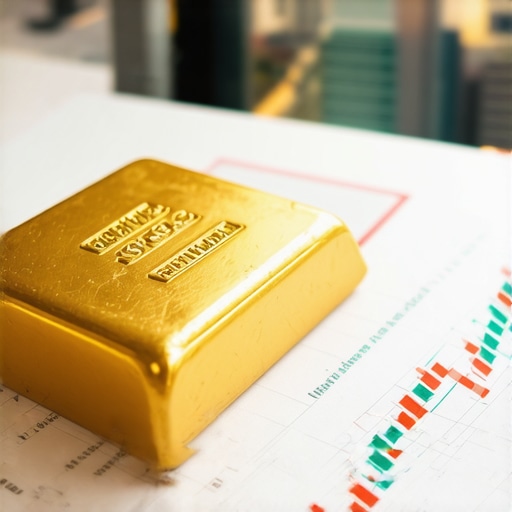Understanding Gold Exchange-Traded Funds (ETFs)
Gold Exchange-Traded Funds (ETFs) have gained immense popularity among investors looking to capitalize on the stability and appreciation potential of gold. These investment vehicles allow you to gain exposure to gold prices without the complexities of owning physical gold. By investing in a gold ETF, you can buy shares that represent a specific amount of gold, making it a convenient and cost-effective way to diversify your portfolio.
Benefits of Investing in Gold ETFs
One of the primary advantages of gold ETFs is their liquidity. Unlike physical gold, which can be cumbersome to buy and sell, gold ETFs are traded on major stock exchanges, allowing investors to quickly enter or exit positions. Additionally, they typically have lower management fees compared to mutual funds, enabling you to maximize your returns.
Moreover, gold ETFs often hold physical gold bullion, which means that they directly track the price of gold. This direct correlation can be particularly beneficial in times of economic uncertainty, when gold prices tend to rise as investors seek safe-haven assets. For further insights on how gold performs as a safe haven, you might explore 2025 Gold Price Forecast: Insights from Industry Experts.
Choosing the Right Gold ETF
When selecting a gold ETF, it’s essential to consider factors such as the expense ratio, the physical gold holdings, and the fund’s liquidity. Look for ETFs with a low expense ratio to ensure that more of your investment goes toward actual returns rather than fees. Additionally, some ETFs may not hold physical gold but instead invest in gold futures or mining stocks. Understanding the structure of the ETF is crucial for aligning it with your investment strategy.
For those new to gold investments, a comprehensive guide can be beneficial. Check out Investing in Gold: A Comprehensive Guide for 2025 for a deeper understanding of how to incorporate gold into your investment portfolio.
Strategies for Maximizing Returns with Gold ETFs
To maximize your returns with gold ETFs, consider adopting a strategic approach. Dollar-cost averaging is one effective strategy, where you invest a fixed amount regularly, regardless of gold prices. This strategy can help mitigate the impact of market volatility by averaging out the purchase cost over time.
Additionally, staying informed about market trends and geopolitical events is vital for making timely investment decisions. Gold prices can be influenced by various factors, including inflation rates, currency fluctuations, and central bank policies. For instance, understanding how central bank gold purchases affect prices can provide insights into market movements. You can read more about this in Understanding How Central Bank Gold Purchases Affect Prices.
By employing these strategies, you can effectively navigate the gold market and enhance your investment outcomes. Whether you are a seasoned investor or just starting, leveraging the benefits of gold ETFs can play a significant role in maximizing your returns.
Advanced Strategies for Gold ETF Investment
While the fundamentals of investing in Gold Exchange-Traded Funds (ETFs) are crucial, employing advanced strategies can significantly enhance your investment returns. Understanding market timing, leveraging technical analysis, and using options can provide an edge in maximizing profits.
Market Timing: When to Invest in Gold ETFs
Market timing involves making investment decisions based on market conditions and trends. An effective approach is to monitor gold price movements and economic indicators closely. For instance, during periods of economic instability or high inflation, gold often serves as a hedge, leading to price appreciation. Investors may want to consider investing in gold ETFs during these times to capitalize on potential gains. For more insights on how gold acts as a hedge, visit How Gold as a Hedge Can Secure Your Financial Future.
Using Technical Analysis for Investment Decisions
Technical analysis involves studying price patterns and market trends to make informed investment decisions. By analyzing historical price data, investors can identify potential support and resistance levels in gold ETF prices. Tools such as moving averages, Relative Strength Index (RSI), and candlestick patterns can provide valuable insights into when to buy or sell gold ETFs. For those interested in technical analysis, resources like Analyzing Gold Prices Today: Key Insights for Investors can offer further guidance.
Leveraging Options to Enhance Returns
Options trading is another advanced strategy that can be utilized to maximize returns on gold ETFs. Investors can use call options to speculate on price increases or put options to protect against declines. This strategy allows for flexibility and can enhance portfolio returns while managing risks. If you’re new to options trading, it’s important to understand the basics before diving in. Consider reading A Beginner’s Guide to Gold Trading Techniques for 2025 for essential insights.
Risk Management: Protecting Your Investment
In any investment strategy, risk management is paramount. Setting stop-loss orders on your gold ETFs can help limit potential losses, ensuring you protect your capital against adverse market movements. It’s essential to review your investment periodically and adjust your strategy based on market conditions and personal financial goals. For a comprehensive understanding of risk management in gold investments, check out Tips for Evaluating Gold Investments: A 2025 Perspective.
Staying Informed: The Importance of Market Trends
Finally, staying informed about global economic trends, geopolitical events, and changes in monetary policy can significantly impact gold prices. Regularly reviewing economic reports and news can help you make timely decisions regarding your gold ETF investments. For instance, understanding the impact of central bank policies on gold prices can provide critical insights. You may find it beneficial to read Understanding the Impact of Geopolitical Events on Gold Prices for deeper knowledge.
Understanding the Role of Gold in Portfolio Diversification
Investing in gold ETFs not only offers exposure to gold prices but also plays a crucial role in portfolio diversification. Gold often behaves differently than stocks and bonds, which can help mitigate overall investment risk. When stock markets are volatile, gold typically retains its value, making it an effective safe haven. For instance, during economic downturns, many investors flock to gold, illustrating its role as a hedge against market instability. To learn more about how gold can stabilize your investments, check out The Role of Gold in Portfolio Diversification: 2025 Tips.
Tax Considerations for Gold ETF Investments
Another important factor to consider when investing in gold ETFs is the potential tax implications. Different forms of gold investments are subject to varying tax rates. For example, profits from selling physical gold are often taxed as collectibles, which can significantly affect your overall returns. In contrast, gold ETFs, classified as securities, may be subject to lower capital gains tax rates. Understanding these tax considerations is essential for optimizing your investment strategy. For a broader understanding of tax implications, you might explore Understanding Gold Price Fluctuations: A 2025 Guide.
Assessing the Performance of Gold ETFs
Regularly assessing the performance of your gold ETFs is vital for maintaining an effective investment strategy. This involves not only reviewing the fund’s price movements but also understanding its correlation with gold prices and macroeconomic factors. Analyzing historical performance can provide insights into how well the ETF responds to market changes. Tools and resources like How to Analyze Trends in the Gold Market for Optimal Investments can assist investors in making informed decisions based on past performance.
Exploring Alternative Gold Investment Options
While gold ETFs offer a practical way to invest in gold, it’s also worth exploring alternative investment options. These include physical gold, gold mining stocks, and gold mutual funds. Each option has its own set of risks and benefits. For example, while physical gold can act as a tangible asset, it also comes with storage and insurance costs. On the other hand, investing in gold mining stocks might offer higher returns but comes with increased volatility. For insights on comparing these options, consider reading Comparing Gold Bars vs. Gold Bullion: Which to Choose?.
Geopolitical Factors Affecting Gold Prices
Geopolitical events can significantly influence gold prices, making it essential for investors to stay informed. Factors such as political instability, trade tensions, and changes in government policies can lead to fluctuations in gold prices. Understanding these dynamics allows investors to make timely decisions regarding their gold ETF investments. Resources like Understanding the Impact of Geopolitical Events on Gold Prices provide valuable insights into how these events shape the gold market.
Emerging Trends in Gold ETF Investments
As we look ahead to 2025, several emerging trends are reshaping the landscape of gold ETFs. Understanding these trends is crucial for investors seeking to optimize their portfolios. One significant trend is the increasing demand from institutional investors. Many large investment firms are incorporating gold ETFs into their asset allocation strategies, recognizing gold’s role as a hedge against inflation and market volatility.
Moreover, the growing popularity of sustainable investing is influencing how gold ETFs are structured. Investors are increasingly seeking environmentally responsible options, prompting ETF providers to consider the sustainability of their gold sourcing. This shift may lead to the development of gold ETFs that prioritize ethical mining practices, catering to environmentally conscious investors. To gain further insights into how gold can act as a hedge, visit How Gold as a Hedge Can Secure Your Financial Future.
The Impact of Central Banks on Gold ETF Markets
Central bank policies significantly impact gold prices and, consequently, gold ETFs. In recent years, central banks have resumed purchasing gold as a strategic move to diversify their reserves amid global economic uncertainties. This trend is expected to continue into 2025, further enhancing gold’s appeal as a safe haven. Investors should stay informed about central bank activities, as these can influence market sentiment and drive gold prices higher.
For a deeper understanding of how central bank gold purchases affect prices, check out Understanding How Central Bank Gold Purchases Affect Prices. Keeping abreast of these developments will be vital for making informed investment decisions.
Technological Advancements in Gold Trading
Technological advancements are also making gold trading more accessible and efficient. With the rise of fintech companies, investors can now trade gold ETFs via user-friendly platforms, reducing barriers to entry. Additionally, blockchain technology is being explored for enhancing transparency in gold transactions, providing investors with greater confidence in their investments. This technological evolution is likely to attract a broader range of investors to the gold market, particularly younger generations who value innovation.
Gold ETFs and Inflation Hedge Strategies
As inflation concerns loom large in the financial landscape, gold ETFs are increasingly viewed as a reliable hedge. Historically, gold has maintained its value during inflationary periods, making it a go-to asset for investors looking to preserve purchasing power. In 2025, with inflationary pressures expected to persist, gold ETFs will likely become even more attractive.
Investors can enhance their inflation hedge strategies by combining gold ETFs with other asset classes. For instance, pairing gold ETFs with inflation-protected securities can provide a diversified approach to mitigating inflation risks. To explore this further, you may find value in reading 2025 Gold Price Forecast: Insights from Industry Experts.
The Role of Geopolitical Stability in Gold Investments
Geopolitical stability is another critical factor influencing gold prices and ETF performance. Political unrest, trade wars, and economic sanctions can all drive investors toward safe-haven assets like gold. As the geopolitical landscape evolves, understanding these dynamics will be essential for gold ETF investors. Regularly monitoring news and market analyses can help you stay ahead of potential shifts that may impact your investments. Resources like Understanding the Impact of Geopolitical Events on Gold Prices can provide valuable insights into these trends.
By staying informed and adapting to the evolving landscape of gold investments, you can position yourself to maximize returns and effectively navigate the complexities of the gold ETF market.
Frequently Asked Questions about Gold ETFs
What are Gold ETFs and how do they work?
Gold ETFs (Exchange-Traded Funds) are investment funds that are traded on stock exchanges, similar to stocks, and are designed to track the price of gold. They allow investors to gain exposure to gold without physically owning it. Each share of a gold ETF typically represents a specific amount of physical gold, providing a cost-effective and liquid way to invest in this precious metal.
Why should I invest in Gold ETFs?
Investing in Gold ETFs offers several benefits including liquidity, lower fees, and the ability to diversify your portfolio. Gold is often viewed as a safe-haven asset, particularly during economic uncertainties, which can help protect your investments against market volatility.
How do I choose the best Gold ETF?
When selecting a Gold ETF, consider factors such as the fund’s expense ratio, the amount of physical gold it holds, its historical performance, and its liquidity. Research different ETFs and compare their features to find one that aligns with your investment goals.
Are there any risks associated with Gold ETFs?
Yes, while Gold ETFs can be a good investment, they are not without risks. These include market risk, liquidity risk, and the potential for tracking error, where the ETF’s performance may not perfectly match the price of gold. It’s essential to conduct thorough research and consider your risk tolerance before investing.
How are Gold ETFs taxed?
Tax treatment for Gold ETFs can vary based on jurisdiction. In many cases, profits from Gold ETFs are taxed as collectibles, which can incur higher capital gains tax rates. It is advisable to consult with a tax professional to understand the specific implications for your investments.
Can I invest in Gold ETFs in a retirement account?
Yes, many investors choose to hold Gold ETFs in tax-advantaged retirement accounts like IRAs. However, it’s important to ensure that the specific Gold ETF is allowed by the account custodian and to understand any associated fees.
What is the difference between Gold ETFs and physical gold?
The main difference lies in ownership and liquidity. Gold ETFs provide exposure to the price of gold without the need to store or insure physical gold. Physical gold requires additional considerations such as storage costs and security, while Gold ETFs can be bought and sold easily on stock exchanges.
How do geopolitical events affect Gold ETFs?
Geopolitical events such as conflicts, trade tensions, or changes in government policies can lead to increased demand for gold as a safe-haven asset, driving up its price. Consequently, Gold ETFs tend to benefit from such events as their value is closely tied to the price of gold.
Are there any sustainable Gold ETFs available?
Yes, some ETF providers are developing sustainable Gold ETFs that focus on ethical sourcing and environmentally responsible mining practices. These options cater to socially conscious investors looking to align their investments with their values.
Authority Resources for Gold ETF Investors
For those looking to deepen their understanding of Gold ETFs and the gold market, several trusted resources can provide valuable information:
- SPDR Gold Shares – One of the largest gold ETFs, offering insights into gold investment.
- iShares Gold Trust – Provides data and performance tracking for their popular gold ETF.
- World Gold Council – A leading authority on gold, offering research and education on gold investments.
- Kitco Metals – Offers real-time gold prices and market analysis.
- Investopedia – Comprehensive articles and guides on investing in gold and Gold ETFs.
Conclusion
In summary, investing in Gold ETFs presents a unique opportunity to gain exposure to gold’s price movements while enjoying the benefits of liquidity and diversification. By understanding the various strategies, risks, and market dynamics, you can make informed decisions that align with your investment goals. Whether you’re a seasoned investor or new to the gold market, leveraging Gold ETFs can enhance your portfolio and provide a hedge against economic uncertainties. Stay informed through authoritative resources and continuously adapt your strategies to navigate the evolving landscape of gold investments.










I’ve been exploring gold ETFs recently and one aspect that really stood out from this post is the emphasis on the liquidity advantage they offer over physical gold. As someone who tried owning physical gold before, I can attest to the hassles of storage and selling it quickly when needed. Gold ETFs seem like a smart way to bypass those issues while still gaining exposure to gold prices. That said, the note about selecting ETFs with low expense ratios and ensuring they hold physical gold resonates as well — not all ETFs are created equal, and it’s crucial to understand their structure before investing.
The dollar-cost averaging strategy recommended here also caught my attention. Market volatility often makes timing investments tough, so spreading out your purchases can help mitigate risks. I’m curious how others manage the balance between timing the market and using this steady investment approach, especially during periods of inflation and geopolitical uncertainty. Does anyone have personal experience combining these strategies effectively?
Overall, gold ETFs appear promising for portfolio diversification and risk management, but I wonder how much research is needed upfront to choose the right fund and stay informed on global events that impact gold prices. How do you others keep up with this constantly changing landscape?
I appreciate the detailed breakdown of gold ETFs and their advantages. One aspect that I think deserves additional emphasis is the significance of liquidity combined with cost efficiency when compared to owning physical gold. Having invested previously in physical gold, I found the logistical issues, such as secure storage and high insurance costs, to be major deterrents. Gold ETFs eliminate these hurdles by offering an easy and cost-effective alternative that still mirrors the price movements of actual gold.
Regarding the concern around selecting the right gold ETF, I’ve learned from experience how critical it is to evaluate the fund’s structure closely. Some ETFs invest indirectly through futures or mining stocks, which can introduce volatility unrelated to the actual gold price. Opting for ETFs backed by physical bullion with lower expense ratios generally leads to better alignment with gold market performance.
On balancing dollar-cost averaging with market timing, I believe that maintaining a disciplined investment schedule during uncertain times, like inflationary periods or geopolitical tensions, helps reduce emotional decision-making. That said, supplementing this with periodic reviews of market trends and economic indicators, maybe quarterly, can offer windows to adjust allocations prudently.
For others who actively research to stay up-to-date, what methods or resources have you found most effective in tracking global events impacting gold prices without becoming overwhelmed by information overload?